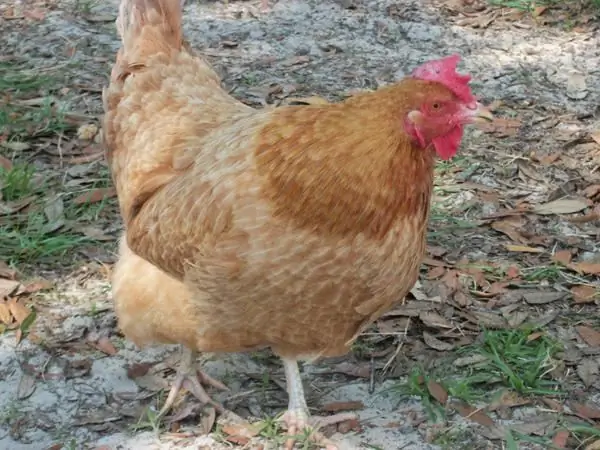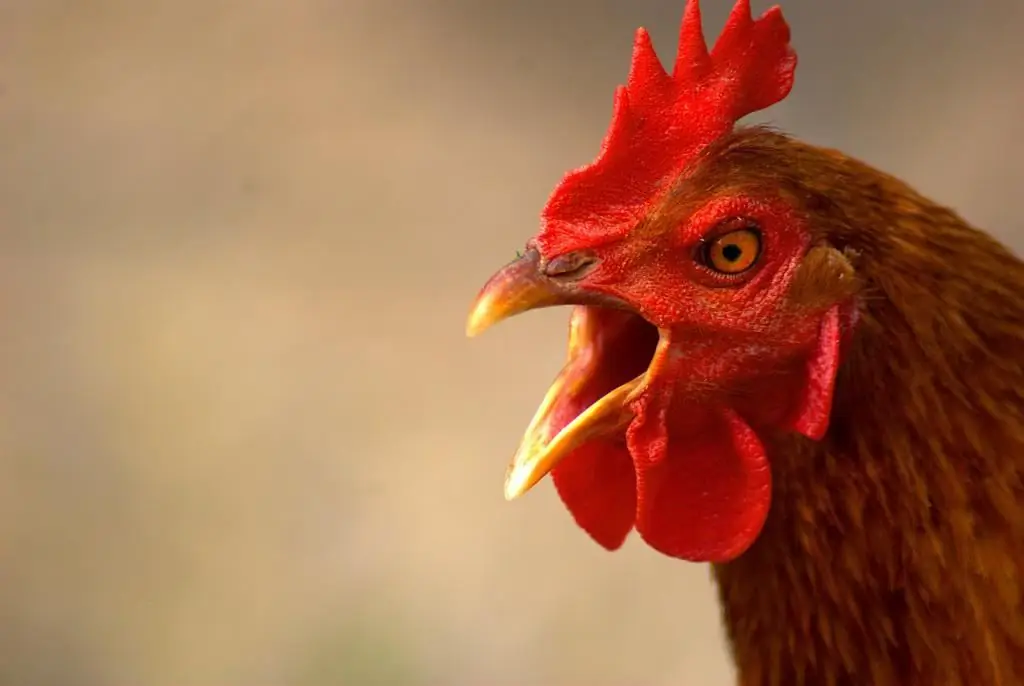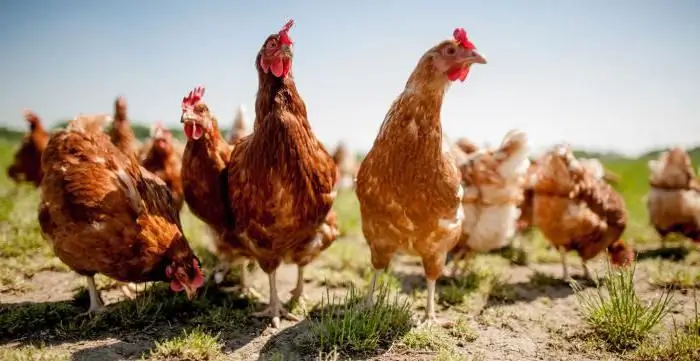2026 Author: Howard Calhoun | [email protected]. Last modified: 2025-06-01 07:12:56
The productivity and he alth of a chicken depends on the quality of its nutrition. And it doesn’t matter for what purpose and where the bird is kept: in a poultry farm or in a private courtyard, the main thing is to watch what the chickens eat. They need to be given only high-quality and nutritious feed, rich in all the necessary trace elements and vitamins, which will only benefit the bird. As a result of a good, balanced diet, the chicken will produce large, tasty eggs.

Feed content
No matter where chickens are raised, their diet should be varied and nutritious. At poultry farms, the diet is dry food for chickens, and at home it can be diversified by giving the bird grass and vegetables.
In poultry nutrition, proteins, fats, vitamins, trace elements, carbohydrates must be balanced.
Proteins
The main component of the egg is protein. It is necessary for chickens for the normal development of the body. Cake, sunflower meal, soybeans, legumes are added to the feed for laying hens at home. These are protein sources.vegetable origin. Also in the diet should be animal proteins. Their chickens can be obtained with meat and bone or fish meal, earthworms, mollusks. In private backyards, if a bird roams freely, then it can get itself some of the proteins of animal origin. In industrial cultivation, fish or meat and bone meal is added to the feed.
Fats
Chickens get their energy from fat. These elements are deposited in the subcutaneous layer, and from there the reserves are consumed. Part goes to energy, and the other goes to the formation of the egg. In order for the bird to be strong, vigorous, and rush well, corn and oats are added to chicken feed at home. These are fat-rich foods. And when corn is added, the egg yolk acquires a beautiful, rich orange color.
Carbohydrates
Carbohydrates are needed to ensure the work of all muscles and organs. What chickens eat determines their productivity. If there is a sufficient amount of carbohydrates in the diet, then the bird will rush well and develop quickly enough.
Carbohydrates a bird can get from succulent feed: potatoes, beets, pumpkins, zucchini, carrots.
Vitamins
For normal life, the bird must receive a sufficient amount of vitamins with food. Of particular importance are vitamins D, B, A. With their lack, the bird begins to get sick: it falls to its feet, productivity decreases. The main sources of vitamins are grass, fish oil, baker's yeast.
Minerals
Many farmers wonder why chickens eat their eggs. Most often this is associated withmicronutrient deficiencies. It is from them that the construction of the egg shell, the skeleton of the chicken takes place. To make up for the lack of calcium and other nutrients, birds should always have chalk, gravel, wood ash or shells in a separate bird feeder.
Feed balance
The diet may consist of ready-made compound feed, which is sold in bird markets, in veterinary pharmacies. You can make your own food by mixing different grains.
When buying feed, you should avoid products containing dyes, growth hormones, flavor enhancers. The nutritional value of poultry feed should be as follows:
- proteins - from 15 to 19%;
- fiber - 5%;
- ash, potassium, calcium, amino acids, vitamins, copper, selenium and other beneficial trace elements.
When choosing compound feed, preference should be given to those products that are produced by proven factories.

Food for domestic chickens can be given in feeders, or you can sprinkle it on the walker. When using factory compound feed, it is necessary to provide the bird with constant access to water: 0.5 l of water is needed per bird per day. Do not put a container of water in the chicken coop due to the risk of increasing humidity. This will adversely affect the he alth of the bird.
You should know what chickens eat 80 grams of feed per day. At home, the diet must be diversified by adding juicy food, grass to it. Dry food for chickens should not be the only type of food. Even on poultry farms, where chickens are fed with compound feed, various nutritious foods are added to it.substances. Most often, these are growth stimulants, vitamins, chalk, shell and other types of supplements.
Grass, succulent food
Necessary feeding for laying hens are succulent feed and grass. The composition and quality of the yolk depends on the quality of the greens. Free-range birds do not have a shortage of fresh greens. Those birds that are kept in cages or in a closed walker may be deficient in grass. Because of this, the bird can get sick, have a variety of he alth problems. To avoid this, you should include grass and other useful substances in your daily diet.

As a top dressing for the main feed, chickens are given freshly cut grass, including lawn, waste from the garden, peeling vegetables, fruits. They perfectly eat weeds, green manure crops.
Cabbage of any variety will be a good addition to the chicken table. It contains substances that prevent cannibalism.
Pumpkin, zucchini, apples should be introduced into the diet. In some yards, you can see tied bunches of grass. To get to them, the chickens have to jump up and down. This is done to provide adequate exercise for birds kept in cramped coops and small walkers.
Succulent feed diet
The chicken menu may include:
- Potatoes. Sprouted, small potatoes, peelings are suitable for food. Up to one hundred grams can be given per day per individual.
- Bread. Few people know that chickens eat bread. They are given dried, stale pieces, after soakingwater.
- Waste from the kitchen table. Fish giblets, heads, leftover soups, pasta, meat dishes have a positive effect on the productivity of laying hens.
- Protein products. Chickens can be given cottage cheese, curdled milk, whey. These products contribute to the replenishment of protein and calcium in the body of the bird, increasing egg production.
It is useful to give boiled vegetables, fresh fruits.
Forage harvesting
In the winter season, the bird should be given foods rich in trace elements and vitamins. If you prepared food for chickens in advance, then in the cold season the bird will delight with an egg.
From the second half of summer and autumn, grass seeds, leaves and berries of wild shrubs and trees are harvested for birds. It can be mountain ash, hawthorn, wild rose, chestnuts. Herbal brooms are also prepared from nettle, alfalfa and other useful herbs. Herbs are crushed and dried in the shade, in a well-ventilated place. In winter, they are added to the mash and fed to the bird.

Preparing food for feeding
Before you give food to the chicken, it must be prepared. This is done to increase its nutritional value and improve the digestibility of the laying hen's body.
- Potato and its sprouts. As you know, potato sprouts contain solanine. This is a poisonous substance that can kill a chicken. To remove it from the product, potatoes are boiled or steamed.
- Root crops. For better pecking of zucchini, beets, pumpkins and other root crops, they are pre-rubbedgrated or chopped with a food processor. Then the vegetables are added to the main feed (compound feed, crushed grain, corn). In this form, food is given to the bird.
- Before giving chicken grains, it is recommended to chop them.
- Beans are pre-soaked before feeding.
In the winter season, it is useful to give sprouted grain to chickens. To obtain it, whole barley or wheat is taken, poured in a thin layer into a container (on a tray), filled with water. After three days the product is ready to be fed.

Feed Compilation
It's easy to make a balanced diet on your own. To do this, you can focus on the following calculations:
- potatoes - 100 grams;
- cake or sunflower meal - 7-10 grams;
- s alt - no more than 0.5 grams;
- baker's yeast - 1 gram;
- chalk - not less than 3.5 grams;
- wet mash (corn - 50%, barley, wheat, bran 25% each) - 30 grams.
Grass must be included in the diet. Potatoes can be replaced with other vegetables or mixes of different vegetables, fruits in the amount of 100 grams per bird.
You can compose other kinds of menus. For example, the following composition is suitable for the summer period:
- flour mixture - 50 grams;
- cereals - 50 grams;
- hard juicy food - 40 grams;
- protein feed - 15 grams;
- bone meal - 2 grams;
- s alt, mineral supplements - no more than 5.5 grams.
In winterseason, the diet should be somewhat different. In it, green fodder is replaced with mashes in which dry grass is added. When compiling a diet, you can use the following composition:
- dry herbs - 15 grams;
- potatoes or other root vegetables - 100 grams;
- cereals - 50 grams;
- mash - up to 30 grams;
- meal, cake - 7-10 grams;
- meat and bone meal - up to 2 grams;
- mineral supplements - no more than 5 grams;
- dairy products - 100 grams.
Ready-made feed for laying hens has all the necessary substances in its composition. However, for a personal farmstead, such feed is expensive, it is unprofitable to buy them. It is much more profitable to compose the feed yourself.
Features of feeding laying hens at different times of the year
Knowing how much feed a laying hen needs per day, you can organize the right feeding. To maintain good egg production, the bird is fed four times a day. However, such a regimen is difficult to maintain, because many people work and cannot leave work to feed chickens. Therefore, they are most often fed two to three times a day.
With three meals a day, the daily dose is divided into three doses, and with two meals - two. In any case, feed the bird at regular intervals.
The first feeding should be as early as possible in the morning, the last - as late as possible. In the evening, chickens are encouraged to give grain. The rest of the time, mixers and vitamin feeds are given. If you plan to feed the layers twice a day, then the diet is divided so that most of the mashand vitamin feed came in the morning, and in the evening the bulk of the diet consisted of grain. In the winter season, the mash is given warm.

Many people are interested in the question of how much feed chickens need per day. It is definitely impossible to answer it. The exact amount depends on the type of feed. If this is feed for laying hens, then it is given at the rate of 80 grams per individual (the amount may be more or less, depending on the type of feed). For a more accurate dosage, please refer to the feed manufacturer's instructions.
If you give the bird its own feed, then the chicken eats from 150 to 250 grams of feed per day. The exact amount depends on the season, composition.
For a more accurate determination of the feeding rate, calculations are made. A bird weighing up to 1.8 kilograms with a productivity of 100-110 eggs per year is given about 130 grams of feed per individual. If a chicken weighs 2 kilograms, then she needs 135 grams of feed. Further, for every 250 grams of weight, 10 grams of feed is added. Egg production should also be taken into account. For every additional 30 eggs per year, 10 grams of feed is added.
Feeding during shedding
During the period of decreasing daylight hours and decreasing egg production, hens begin to molt. At this time, the bird needs to provide good nutrition with an increased amount of minerals. Sulfur is added to the diet. In terms of composition, food is made more diverse, but not high in calories (part of the grains are replaced with vegetables, grass, vitamin feed).
Knowing how much a chicken eats, you can easily make the right dietfor different life cycles.

Chickens are hardy birds that are easy to keep. But this does not mean that they can be fed with any food. So that the bird does not get sick, there is no case, it must be fed only with high-quality feed. You can not give bad, moldy grain, moldy bread. This can cause poisoning, as a result, the bird will die. The diet should contain high-quality grains, fresh grass, boiled potatoes, chalk, shells, gravel and other useful substances.
Proper feeding with good food, a varied diet will please the bird, and she will delight her owners with good, large eggs and tasty meat.
Recommended:
Kuchinsky anniversary chickens. Meat chickens. Egg breeds of chickens

Poultry farming has been extremely popular with our peasants since ancient times. Chickens and ducks required little care, in the summer they found food on their own, and the eggs and meat received from them were a valuable source of protein, which was so necessary in a difficult rural lifestyle
Cannibalism in chickens: causes and treatment. Features of keeping chickens

Cannibalism in chickens is a rather creepy sight that can scare even an experienced farmer. Of course, this brings serious losses to any economy. Therefore, it is especially important to know how to act in such a situation in order to quickly solve the problem
Homestead farming: what do broiler chickens eat

Broilers grow fast but are prone to various diseases. The success of their cultivation depends primarily on the quality of their diet. Therefore, many owners of personal farms have a question about how to feed them
What not to feed chickens: recommendations from poultry farmers

Many novice farmers are interested in what can and cannot be fed to domestic chickens. Typically, garden and kitchen waste is used for this purpose. The bird can be given potatoes unsuitable for use. Suitable green, too small or germinated tubers
Cross chickens. Growing chickens at home for beginners. Hybrid chicken breeds

Successful breeding of chickens of any kind depends on the right breed, conditions of detention, feeding, personal desire to breed poultry. One of the most popular breed groups are chicken crosses. These are poultry hybrids obtained by crossing different breeds. Such a process is complex and is carried out only by specialists according to strictly established rules

